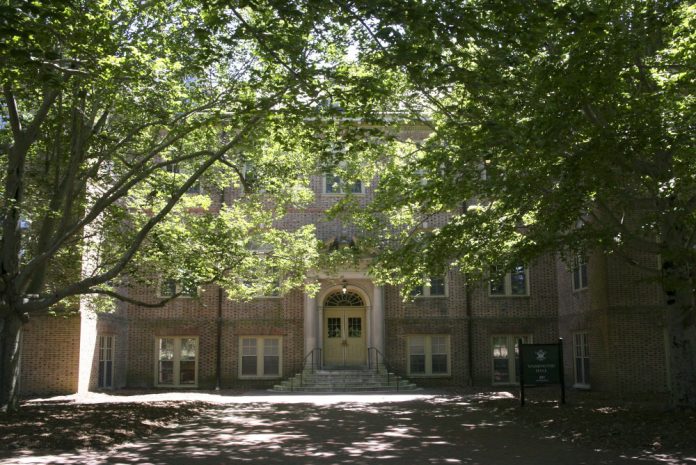Tuesday, Jan. 3 – Friday, Jan. 20, assistant teaching professor of Hispanic studies Dr. Catherine Brix led a group of 18 undergraduate students from the College of William and Mary during a human rights work-focused study abroad program in La Plata, Argentina. The Comisión Provincial por la Memoria, a partner with the College, designed the program itinerary and guided the attending faculty and students through local museums, art collections and other sites of memory.
Brix began teaching at the College in 2021 after completing her doctorate in Spanish at the University of Notre Dame. This past fall, she taught a course on human rights in Argentina that coincided with the La Plata curriculum.
The Winter La Plata program was open to students from all majors and of all Spanish-speaking abilities. Prior to attending, students completed a one-credit prerequisite in the fall. While in Argentina, they earned three credits for GBST 390: “Field Research in Human Rights.”
“Some didn’t speak a lick of Spanish when they went,” Brix said. “Some had, you know, functional knowledge and were able to, you know, communicate on basic things. But it was pretty widespread in terms of majors as well as the degree of fluency.”
Oscar Lazo ’25, a double major in government and Hispanic Sstudies, found the trip to be an apt mix of his academic interests.
“I focus a lot on political stuff on campus, but also just like the Spanish language,” Lazo said. “So to be able to go on a study abroad program which blends the two together, because it is so human rights-focused, and I do a lot of Diversity, Equity and Inclusion work on campus. So, it was kind of like the nexus of everything that I do.”
Brix credited the College’s long-standing relationship with the Comisión Provincial por la Memoria, or the Commission for Memory, for the group’s decision to hold the program in La Plata.
“I would say first and foremost, our partnership with the Comisión Provincial por la Memoria, who we work with on many of our programs in Argentina,” Brix said. “They are probably the foremost institution on the subject of human rights in the country.”
“They are probably the foremost institution on the subject of human rights in the country.”
According to Brix, part of Argentina’s current excellence in the human rights field is due to its handling of the past.
“In Argentina, I think particularly, there is a culture that is very open to discourse on the need to protect human rights,” Brix said. “They’re very cognizant and aware of their position historically, politically, socially on these issues and being a leader in prevention too.”
From 1976-83, a military dictatorship under the name of the National Reorganization Process ruled Argentina during the Cold War. During the period of dictatorship, many citizens were brutalized.
“Over 30,000 people were systematically tortured, murdered and disappeared during this period of time from 1976 to 1983,” Brix said. “After that took place, Argentina was extremely active, in my opinion, in looking at the human rights abuses that took place during that period of time, and [was] very active in seeking mechanisms to achieve accountability and justice for those crimes.”
Upon achieving liberation in 1983, the Argentinian government established the CPM, among several other organizations, for reconciliation.
“They have several different functions,” Brix said. “They’re part of the government, it’s a state institution. They provide education, obviously, for programs like this where they work with students. They do a lot of public outreach and communication in terms of journalism and things like that. They also serve very important functions in terms of continuing to ensure that rights are not being abused.”
Of all the sites of memory visited during the two-week program, both Brix and Lazo felt particularly taken aback by their tour of the Escuela Superior de Mecánica de la Armada.
Over the past 50 years, the ESMA has been converted from a military institution to a concentration camp to a site for human rights. A survivor of the ESMA camp during the dictatorship period led the group’s tour.
“Being led through her experiences, being led through where she was detained, being held, where she was tortured and abused, as she put it,” Lazo said. “It just really puts into reality the atrocities that occurred in Argentina.”
Cade Bridges ‘26 experienced a similar sentiment during the visit to a maximum security prison in Bueno Aires.
“It made the abuse feel more human,” Bridges said. “Like, why don’t we treat prisoners as humans.”
The CPM program visits the sites, in part, to provoke reflection afterwards.
“We regularly have a meeting space where we reflect on the experiences we live in the Program,” CPM’s website reads. “The space is in English and with two [professors] from William & Mary University where we can exchange ideas about the sensations that the people and place we met left us.”
After the program, Brix said her experience leading the La Plata program is a highlight of her academic career.
“Obviously, I’d love to go back,” Brix said. “It’s a fantastic place. It’s a transformative place. It’s a beautiful experience. It’s challenging, but one of the most transformative experiences that I’ve had as an educator.”
In early March, the College’s Hispanic studies department is hosting a symposium for students from Brix’s Human Rights in Argentina course and students from other Hispanic Studies majors to present their final projects.

